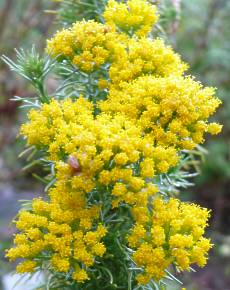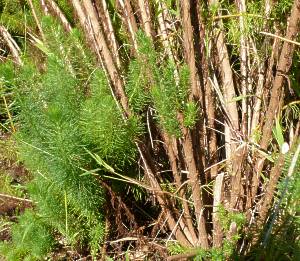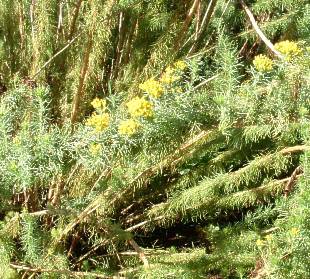Phymaspermum acerosum
Phymaspermum acerosum (DC.) Källersjö
Family: Asteraceae
Common names: geelblombos (Afr.), isibhaha-segceke, umhlonishwa (Zulu)
Introduction
The geelblombos will brighten up any dull area in the garden during the autumn months.

Description
Description
The geelblombos, from the summer rainfall area, is an erect straggly shrub, reaching a height and width of 1.5-2 m. It is a multi-stemmed perennial with woody, densely leaved stems. The leaves are 10-45 mm long with a large glandlike swelling at the base of the midrib on the underside of the leaf. The leaves are finely divided with 5-7 lobes or they can be simple. The lobes are 3-30 mm long.
The flowers occur in large, dense, flat topped inflorescences, which are 200-250 mm in diameter and are bright yellow. Flowering occurs from April until June (autumn).

Conservation Status
Status
Not threatened.
Distribution and habitat
Distribution description
Phymaspermum acerosum is found growing in colonies along forest margins and in grassland at altitudes of 90-2200 m. It is found in the Eastern Cape, Free State, Kwa-Zulu Natal, Lesotho, Mpumalanga, Swaziland, Gauteng and the Northern Province.

Derivation of name and historical aspects
History
The genus name Phymaspermum is derived from the Greek phyma meaning swelling and sperma meaning seed and the species name acerosum means needle shaped, like a pine needle.
Ecology
Ecology
Phymaspermum acerosum attracts insects and thereby improving the bird life in the garden by attracting insectivorous birds.
Phymaspermum acerosum is a rapid growing pioneer plant and is invading overgrazed grassland.
Uses
Use
In traditional medicine, Phymaspermum acerosum is used as a charm to ward off lightning. Because of it is rapid growth, it is used as a pioneer plant.

Growing Phymaspermum acerosum
Grow
Phymaspermum acerosum can be propagated by sowing seed in spring or autumn, or by cuttings. Once the flowering season has passed and the new shoots begin to grow, heel cutting or stem cuttings can be taken. Select healthy cutting material. Use a rooting hormone, and place cuttings in trays with a light, well-drained medium, under mist with bottom heating. Under these conditions, cuttings should root within weeks.
Once the cuttings have rooted, remove them from the bottom heating and harden them off under a shade net for a week. Pot the cuttings up and leave them under the shade net for three weeks. Thereafter, move them into a sunny area.
Phymaspermum acerosum planted en masse with Leonotus leonurus and different types of sagebushes such as Hemizygia or Syncolostemon, which flower at the same time of year, can brighten up any dull garden by adding contrasting colours as well as give it body and form. It can be used in mixed borders as one of the larger shrubs, planted in the centre or the back of the bed. Geelblombos prefers a sunny area in the garden where the soil is well-drained and well composted. Once it has finished flowering, prune the bush back to promote bushy growth.
References
- Pooley, E. 1998. A field guide to wild flowers of KwaZulu-Natal and the Eastern Region. Natal Flora Publications Trust, Durban.
- Van Jaarsveld, E. 2000. Wonderful water-wise gardening. Tafelberg, Cape Town.
- Pooley, E.2003. Mountain Flowers. A Field Guide to the flora of the Drakensberg and Lesotho. The Flora Publications Trust, Durban.
- Jackson, W.P.U. 1990. Origins and meanings of names of South African Plant Genera. UCT Ecolab Botany Department, Cape Town.
- Powrie, F.1998. Grow South African Plants, Kirstenbosch Gardening Series. National Botanical Institute.
- Hutchings, A., Scott, A.H., Lewis, G. and Cunningham, A.1996. Zulu medicinal plants an inventory. University of Natal Press, Durban.
- Website: Plants of southern Africa : an online checklist. http://posa.sanbi.org.
Credits
Karen Wall
Kirstenbosch National Botanical Garden
July 2008
Plant Attributes:
Plant Type: Shrub
SA Distribution: Eastern Cape, Free State, KwaZulu-Natal, Mpumalanga
Soil type: Sandy, Loam
Flowering season: Autumn, Winter
PH: Acid, Neutral
Flower colour: Yellow
Aspect: Full Sun
Gardening skill: Easy
Special Features:
Horticultural zones











Rate this article
Article well written and informative
Rate this plant
Is this an interesting plant?
Login to add your Comment
Back to topNot registered yet? Click here to register.